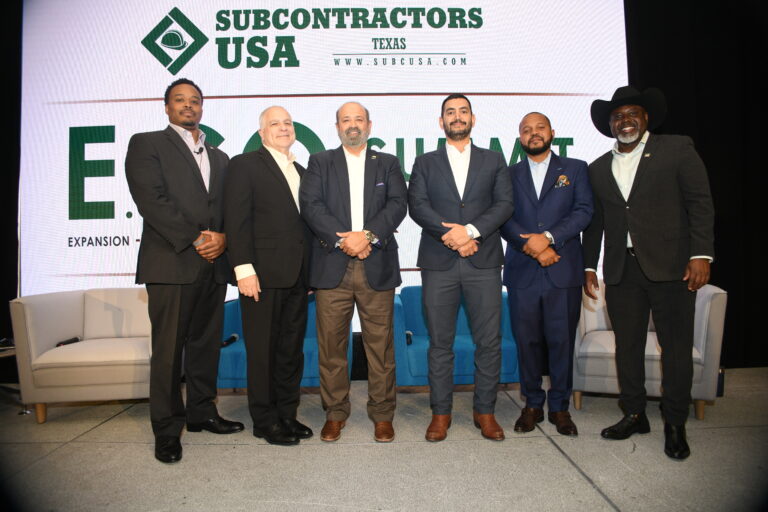
By Subcontractors USA News Provider
Under the OSH Act, employers are responsible for providing a safe and healthy workplace free from recognized hazards likely to cause death or serious physical harm.
Implementing a workplace COVID-19 prevention program is the most effective way to mitigate the spread of COVID-19 at work.
The most effective COVID-19 prevention programs engage workers and their representatives in the program’s development and implementation at every step, and include the following elements:
- Assignment of a workplace coordinator who will be responsible for COVID-19 issues on the employer’s behalf.
- Identification of where and how workers might be exposed to COVID-19 at work. This includes a thorough hazard assessment to identify potential workplace hazards related to COVID-19. This assessment will be most effective if it involves workers (and their representatives) because they are often the people most familiar with the conditions they face.
- Identification of a combination of measures that will limit the spread of COVID-19 in the workplace, in line with the principles of the hierarchy of controls.This should include a combination of eliminating the hazard, engineering controls, workplace administrative policies, personal protective equipment (PPE), and other measures, prioritizing controls from most to least effective, to protect workers from COVID-19 hazards. Key examples (discussed in additional detail below) include:
In addition to these general guidelines, more specific guidance is available for certain industries.
- eliminating the hazard by separating and sending home infected or potentially infected people from the workplace;
- implementing physical distancing in all communal work areas [includes remote work and telework];
- installing barriers where physical distancing cannot be maintained;
- suppressing the spread of the hazard using face coverings;
- improving ventilation;
- using applicable PPE to protect workers from exposure;
- providing the supplies necessary for good hygiene practices; and
- performing routine cleaning and disinfection.
- Consideration of protections for workers at higher risk for severe illness through supportive policies and practices. Older adults and people of any age who have serious underlying medical conditions are at higher risk for severe illness from COVID-19. Workers with disabilities may be legally entitled to “reasonable accommodations” that protect them from the risk of contracting COVID-19. Where feasible, employers should consider reasonable modifications for workers identified as high-risk who can do some or all of their work at home (part or full-time), or in less densely-occupied, better-ventilated alternate facilities or offices.
- Establishment of a system for communicating effectively with workers and in a language they understand. Ask workers to report to the employer, without fear of reprisal (see 12 below), COVID-19 symptoms, possible COVID-19 exposures, and possible COVID-19 hazards at the workplace. Communicate to workers, in a language they can understand and in a manner accessible to individuals with disabilities, all policies and procedures implemented for responding to sick and exposed workers in the workplace. See below for additional elements involving educating and training workers of COVID-19 procedures.
In addition, a best practice is to create and test two-way communication systems that workers can use to self-report if they are sick or have been exposed, and that employers can use to notify workers of exposures and closures, respectively.
- Educate and train workers on your COVID-19 policies and procedures using accessible formats and in a language they understand. Communicate supportive workplace policies clearly, frequently, in plain language that workers understand (including non-English languages, and American Sign Language or other accessible communication methods, if applicable), and in a manner accessible to individuals with disabilities, and via multiple methods to employees, contractors, and any other individuals on site, as appropriate, to promote a safe and healthy workplace. Communications should include:
- Basic facts about COVID-19, including how it is spread and the importance of physical distancing, use of face coverings, and hand hygiene. See About COVID-19 and What Workers Need to Know About COVID-19, above and see more on physical distancing, PPE, face coverings, and hygiene, respectively, below;
- Workplace policies and procedures implemented to protect workers from COVID-19 hazards (the employer’s COVID-19 prevention program); and
- Some means of tracking which workers have been informed and when.
In addition, ensure that workers understand their rights to a safe and healthful work environment, whom to contact with questions or concerns about workplace safety and health, and their right to raise workplace safety and health concerns free of retaliation. This information should also be provided in a language that workers understand. (See Implementing Protections from Retaliation, below.) Ensure supervisors are familiar with workplace flexibilities and other human resources policies and procedures.
- Instruct workers who are infected or potentially infected to stay home and isolate or quarantine to prevent or reduce the risk of transmission of COVID-19. Ensure that absence policies are non-punitive. Policies that encourage workers to come to work sick or when they have been exposed to COVID-19 are disfavored. See below for additional guidance involving eliminating the hazard.
- Minimize the negative impact of quarantine and isolation on workers. When possible, allow them to telework, or work in an area isolated from others. If those are not possible, allow workers to use paid sick leave, if available, or consider implementing paid leave policies to reduce risk for everyone at the workplace. The Families First Coronavirus Response Act provides certain employers 100% reimbursement through tax credits to provide employees with paid sick leave or expanded family and medical leave for specified reasons related to COVID-19 through March 31, 2021.
- Isolating workers who show symptoms at work. Workers who appear to have symptoms upon arrival at work or who develop symptoms during their work shift should immediately be separated from other workers, customers, and visitors, sent home, and encouraged to seek medical attention. See below for additional elements involving screening and testing.
- Performing enhanced cleaning and disinfection after people with suspected or confirmed COVID-19 have been in the facility. If someone who has been in the facility is suspected or confirmed to have COVID-19, follow the CDC cleaning and disinfection recommendations. This includes:
- Closing areas used by the potentially infected person for enhanced cleaning.
- Opening outside doors and windows to increase air circulation in the area.
- Waiting as long as practical before cleaning or disinfecting (24 hours is optimal).
- Cleaning and disinfecting all immediate work areas and equipment used by the potentially infected person, such as offices, bathrooms, shared tools and workplace items, tables or work surfaces, and shared electronic equipment like tablets, touch screens, keyboards, and remote controls.
- Vacuuming the space if needed. Use a vacuum equipped with a high-efficiency particulate air (HEPA) filter, if available. Wait until the room or space is unoccupied to vacuum.
- Providing cleaning workers with disposable gloves. Additional PPE (e.g., safety glasses, goggles, aprons) might be required based on the cleaning/disinfectant products being used and whether there is a risk of splash.
- After cleaning, disinfecting the surface with an appropriate EPA-registered disinfectant on List N: Disinfectants for use against SARS-CoV-2.
- Following requirements in OSHA standards 29 CFR 1910.1200 and 1910.132, 133, and 138 for hazard communication and PPE appropriate for exposure to cleaning chemicals.
Once the area has been appropriately disinfected, it can be opened for use. Workers without close contact with the potentially infected person can return to the area immediately after disinfection.
If it is more than 7 days since the infected person visited or used the facility, additional cleaning and disinfection is not necessary. Continue routine cleaning and disinfection, described below.
- Providing guidance on screening and testing: Follow state or local guidance and priorities for screening and viral testing in workplaces. Testing in the workplace may be arranged through a company’s occupational health provider or in consultation with the local or state health department. Employers should inform workers of employer testing requirements, if any, and availability of testing options. CDC has published strategies for consideration of incorporating viral testing for SARS-CoV-2, the virus that causes COVID-19, into workplace COVID-19 preparedness, response, and control plans. (See below for more on the use of testing to determine when a worker may return to work after illness or exposure.)
Note: Performing screening or health checks is not a replacement for other protective measures such as face coverings and physical distancing. Asymptomatic individuals or individuals with mild non-specific symptoms may not realize they are infected and may not be detected during screening.
- Recording and reporting COVID-19 infections and deaths: Employers are responsible for recording work-related cases of COVID-19 illness on their Form 300 logs if the following requirements are met: (1) the case is a confirmed case of COVID-19; (2) the case is work-related (as defined by 29 CFR 1904.5); and (3) the case involves one or more relevant recording criteria (set forth in 29 CFR 1904.7) (e.g., medical treatment, days away from work). Employers must follow the requirements in 29 CFR 1904 when reporting COVID-19 fatalities and hospitalizations to OSHA. More information is available on OSHA’s website. Employers should also report outbreaks to health departments as required and support their contact tracing efforts.
In addition, employers should be aware that reprisal or discrimination against an employee for speaking out about unsafe working conditions or reporting an infection or exposure to COVID-19 to an employer or OSHA would constitute a violation of Section 11(c) of the Act. In addition, 29 CFR 1904.35(b) also prohibits discrimination against an employee for reporting a work-related illness.
- Implementing protections from retaliation and setting up an anonymous process for workers to voice concerns about COVID-19-related hazards: Section 11(c) of the OSH Act prohibits discharging or in any other way discriminating against an employee for engaging in various occupational safety and health activities. For example, employers may not discriminate against employees for raising a reasonable concern about infection control related to COVID-19 to the employer, the employer’s agent, other employees, a government agency, or to the public, such as through print, online, social, or any other media; or against an employee for voluntarily providing and wearing their own personal protective equipment, such as a respirator, face shield, gloves, or surgical mask.
In addition to notifying workers of their rights to a safe and healthful work environment, ensure that workers know whom to contact with questions or concerns about workplace safety and health, and that there are prohibitions against retaliation for raising workplace safety and health concerns or engaging in other protected occupational safety and health activities (see educating and training workers about COVID-19 policies and procedures, above); also consider using a hotline or other method for workers to voice concerns anonymously.
- Making a COVID-19 vaccine or vaccination series available at no cost to all eligible employees. Provide information and training on the benefits and safety of vaccinations.
- Not distinguishing between workers who are vaccinated and those who are not: Workers who are vaccinated must continue to follow protective measures, such as wearing a face covering and remaining physically distant, because at this time, there is not evidence that COVID-19 vaccines prevent transmission of the virus from person-to-person. The CDC explains that experts need to understand more about the protection that COVID-19 vaccines provide before deciding to change recommendations on steps everyone should take to slow the spread of the virus that causes COVID-19.
- Other applicable OSHA Standards: All of OSHA’s standards that apply to protecting workers from infection remain in place. These standards include: requirements for PPE (29 CFR 1910, Subpart I (e.g., 1910.132 and 133)), respiratory protection (29 CFR 1910.134), sanitation (29 CFR 1910.141), protection from bloodborne pathogens: (29 CFR 1910.1030), and OSHA’s requirements for employee access to medical and exposure records (29 CFR 1910.1020). There is no OSHA standard specific to COVID-19; however, employers still are required under the General Duty Clause, Section 5(a)(1) of the OSH Act, to provide a safe and healthful workplace that is free from recognized hazards that can cause serious physical harm or death.
For more information, please visit www.osha.gov.
Source: U.S. Department of Labor Occupational Safety and Health Administration







